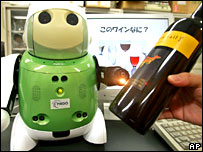
The wine-bot uses infrared sensors to detect wine types
|
A wine-tasting robot has been developed by researchers in Japan.
The so-called robot-sommelier, or "wine-bot", can "taste" and identify types of wine, and also has the ability to discern and analyse foods.
The 2ft-tall (0.6m) robot, developed by NEC System Technologies and Mie University, uses infrared light to identify different tastes.
The Associated Press says the robot could become personalised to recommend wines to suit its owner's palate.
The green and white robot was initially developed to taste and identify foods, analysing the different kinds and quantities of ingredients within them.
But now its tasting technology has moved into the world of wine, and the robot is capable of distinguishing several different types or blends of grapes.
Hideo Shimazu, director of the NEC System Technology Research Laboratory in Japan, told AP: "There are all kinds of robots out there doing many different things.
"But we decided to focus on wine because that seemed like a real challenge."
Limited palate
The tasting robot analyses wines and foods through a sensor on its arm.
Infrared light is fired through the sample, and the robot can differentiate between different types of food and drink by determining the different wavelengths of light that are absorbed.
By using its built-in voice function, the robot can convey exactly what it has found out.
Mr Shimazu said the robot could also be personalised to alert a customer to the wines they prefer, and to recommend to new varieties that they might like to try.
However, the researchers accept that the tasting power of the robot is limited. The global wine market boasts thousands of wines, but the prototype robot can distinguish between just a few dozen varieties.
Atsushi Hashimoto, one of the researchers on the project from Mie University, Japan, said in the future the robot could be used by the wine industry to help in quality control.
Dan Coward, from Bibendum Wine Limited, said: "I love new ideas in wine, but this one seems like technology for the sake of it.
"The human wine taster will always have the upper hand in terms of flavour, smell and texture, and can make qualitative judgements based on the combination of these factors.


~RS~q~RS~~RS~z~RS~08~RS~)